While many may see Ohio as just another state, there are unique features to the Buckeye State. The seventh-most populated state deserves more accolades for its distinct non-rectangular state flag to its landmark contributions to the country. In this article, we focus on the weather and climate of the state, plus reveal the rainiest place in Ohio.
Ohio is exposed to warm, humid fronts from the Gulf of Mexico and cold, dry fronts from Canada. Typically, the state receives about 40 inches (3.3 feet) of precipitation yearly, with an average of 28 inches (2.3 feet) of snowfall due to the frequent front collisions.
In Ohio, summer highs rarely exceed 100 °F (38 °C), while winter lows hardly ever fall below 20 °F (29 °C). The state experiences similar weather patterns to the north-central and eastern United States.
Except for the counties in Ohio’s extreme south, situated on the northern edge of the humid subtropical climate and the Upland South area of the United States, most of the state has a humid continental climate.
Ohio has sporadic damaging tornadoes and minor earth tremors, though it records fewer tornadoes than states in the so-called Tornado Alley.
The state’s climate is also significantly influenced by Lake Erie. Lake effect snowstorms are frequent in a region known as the Snowbelt on the southeast bank of Lake Erie. The snowstorms result from the warming and moistening of arctic air masses over the Great Lakes.
Ohio’s Rainiest Place

Miami Heights, the rainiest place in Ohio, is a suburb of Cincinnati.
©Stephanie A Sellers/Shutterstock.com
Miami Heights is the rainiest place in Ohio with the highest average precipitation. The city records an average rainfall of 44.79 inches (3.7ft). It’s closely followed by Hooven (44.77in) and Edgewood (44.57 in).
Miami Heights’ average temperature is 53.86°F, higher than the 49.45°F average for Ohio and about the same as the 54.7°F average for the entire country.
As of 2020, there were 5,166 residents living in Miami Heights, a census-designated place (CDP) in Miami Township, Hamilton County, Ohio. Miami Heights has a land area of 3.51 square miles and no water area.
Wildlife Around Miami Heights

Acadian flycatchers make Miami Heights, Ohio’s rainest place, their home.
©Agami Photo Agency/Shutterstock.com
Ohio has an abundance of wildlife. Habitats, such as prairies, forests, and wetlands, accommodate about 219 bird species, 39 amphibians, 67 mammals, and 45 snake species. Many of these species can be found in Ohio’s rainiest place, no doubt feeding on the insects, berries, and other food sources that thrive there. Here are some species recorded around Miami Heights.
#1 Carolina Chickadee
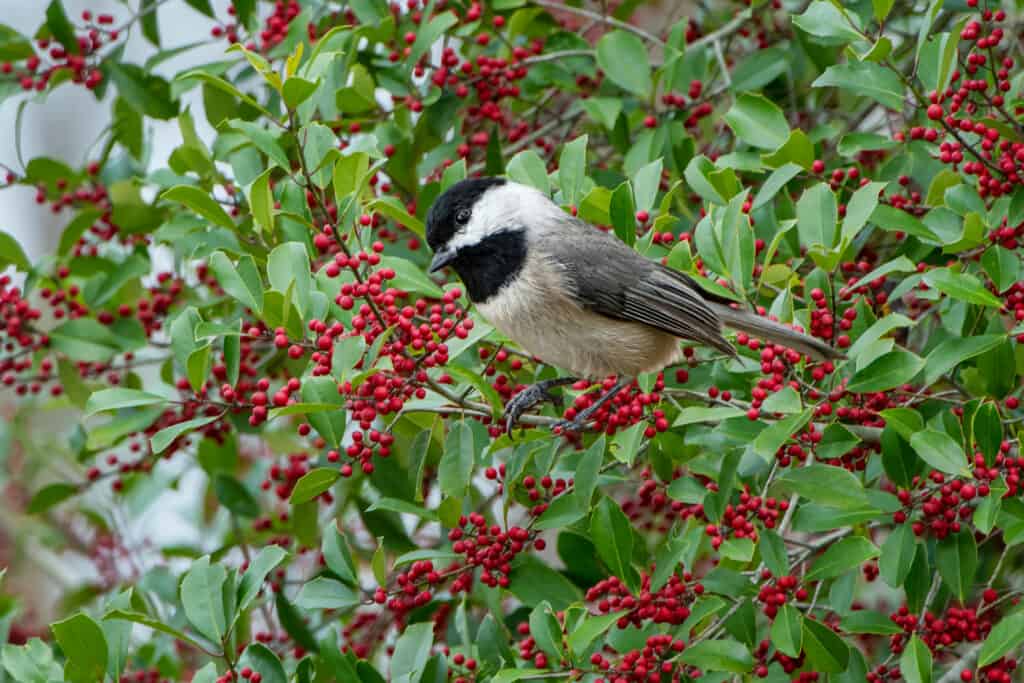
The Carolina
Chickadee
is one of two chickadee species in Ohio.
©Bonnie Taylor Barry/Shutterstock.com
The state has two identical chickadee species: the Carolina chickadee in the south and the black-capped chickadee in the northern end. The cheeks of a Carolina Chickadee are a striking white color, with a black head and bib. Their wings, tail, and back have a gray hue.
Carolina chickadees are typically found in deciduous woodlands, yards in cities and suburbs, and parks with big trees. They build their nests in abandoned woodpecker dens, nest boxes, or hollow stumps. Females use soft plant fibers and downy feathers to construct their nests.
They join the feeding flocks of other tiny bird species, including other Carolina Chickadees, that cover a sizable region except during the mating season. They lay their eggs in birdhouses or tree cavities. As the young are hatched, both the male and female feed them. However, only the female is responsible for egg incubation. The incubation period for clutches of 5-8 eggs is 11–12 days, and the young leave the nest 13–17 days later.
In their search for food, the energetic passerine birds jump between twigs and gather food from the surface. It’s common to see them eat while hovering, hang upside down to access beneath branches, or fly to grab flying insects. They also frequent bird feeders for seeds and suet.
Caterpillars form the bulk of their diet in the summer, consuming more seeds and berries in the winter. Carolina chickadees also eat beetles, small fruits, moths, weeds, aphids, and true bugs.
#2 Northern Flicker

Northern Flicker is a migratory woodpecker and lives in Ohio’s rainiest place.
©Fiona M. Donnelly/Shutterstock.com
The Northern Flicker is a brownish-gray, medium-sized woodpecker species with black bars on its back, a unique black crescent-shaped on its upper breast, and black polka dots all over its beige underside. They are one of the migratory woodpeckers in North America; flickers spend the winter in the southern regions of their range.
The Flicker has vibrant red or gold wing linings and a big white rump patch that is easily seen in flight. Thanks to its long, slightly curved bill, this bird is often spotted on the ground —unlike other woodpeckers—where it forages ants, grubs, and other invertebrates in anthills, decaying wood, and the soil. The Northern Flicker’s tongue is exceptionally long and can reach up to two inches past the end of its beak.
Along with eating fruit, such as wild cherries, sumac, poison ivy berries, wild grapes, and dogwood, this Woodpecker eats other insects and their eggs. Wild fruits and nuts make up the majority of its diet in the winter.
They live in wooded areas and forest borders. They can also be found in marshes, wetlands, and vast fields with huge, dispersed trees. Unlike other woodpecker species, Northern Flickers build their nests in the holes dug by other birds.
#3 Common Yellowthroat
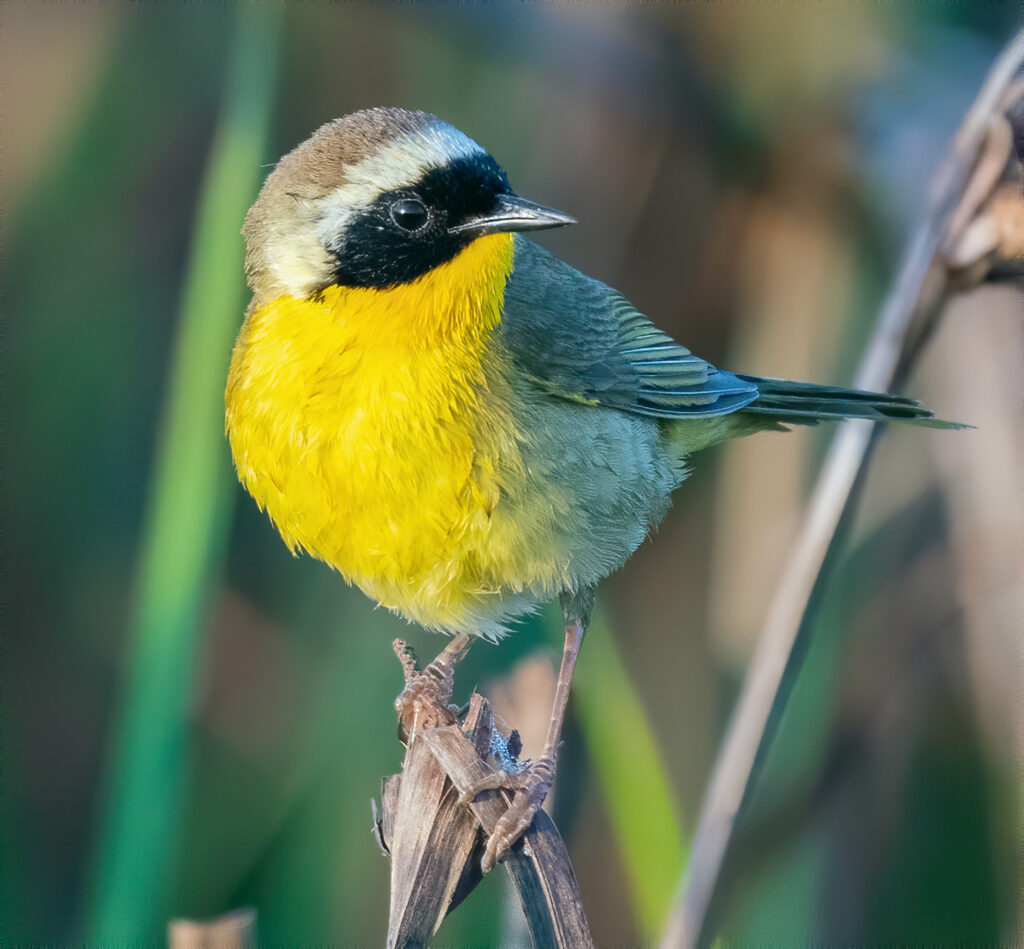
Common Yellowthroat lives throughout North America, including Ohio.
©DC Wildlife Photography/Shutterstock.com
The olive-backed songbirds, often called yellow bandits, are distributed across North America, from southern Canada to central Mexico. It was one of the first bird species in the New World and was originally known as the Maryland yellowthroat.
Yellow bandits move more like a wren than typical warblers. They hop around low, dense vegetation and reeds, never flying very high, and are heard more frequently than seen.
The underside of adult males is bright yellow, while their upper parts are olive with a spiky black face mask. A narrow, white line distinguishes the black mask from the head and neck. Growing males have traces of full masks seen in adults.
The throat and underside of the tail are typically yellow on the females, a simple olive-brown color.
Yellowthroats mostly eat insects, such as beetles, small grasshoppers, grubs, cankerworms, dragonflies, damselflies, mayflies, seeds, and spiders.
They inhabit open spaces with dense, low vegetation, such as marshes, open pine forests, and grasslands. They use various habitats, including backyards and forests, while migrating.
Female Common Yellowthroats build their nests on or close to the ground. First, the parents feed their babies by slipping into the thickest vegetation near the nest. Then, they sneak into the nest and feed the young before fleeing in another direction to avoid potential predators.
#4 Acadian Flycatcher
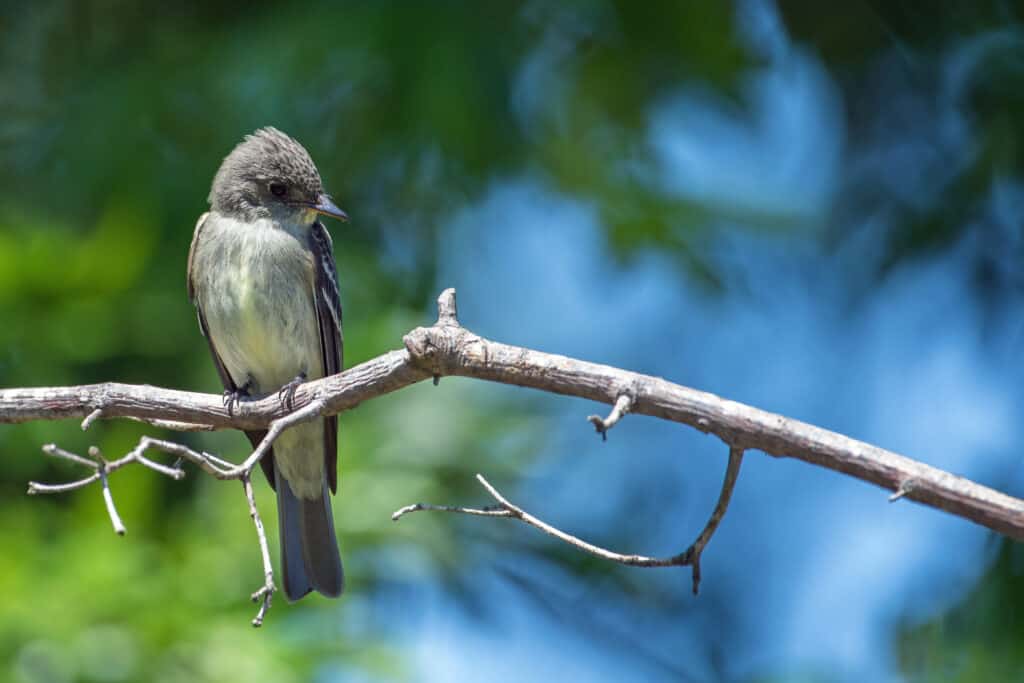
Acadian flycatchers are skilled insect hunters, able to catch flies and other insects while in the air.
©Tom Franks/Shutterstock.com
As the name implies, Acadian flycatchers are skilled at gleaning insects from beneath leaves, even while flying. Acadian flycatchers have been observed to fly backward and are quite maneuverable. Its agility is helpful while gathering insects or berries from branches or aerially hawking (catching insects in the air).
These birds are elusive because they prefer dark, shaded woodlands. Also, female Acadian flycatchers often leave the nest when a potential predator is within 23m. However, they are semi-social during mating season, bonding with nearby Acadian flycatchers.
The primary prey of Acadian flycatchers is insects. They eat flying ants, flies, small moths, small beetles, mosquitoes, insect larvae, and sometimes spiders. Blackberries and raspberries are fruits they’ve been seen to occasionally consume. Young Acadian flycatchers are fed almost exclusively insect-based meals.
North America is home to the little insect-eating Acadian flycatcher. However, it can be tricky to differentiate from other species in the Empidonax genus, such as willow flycatchers, alder flycatchers, least flycatchers, and yellow-bellied flycatchers.
With triangular heads, adult Acadian flycatchers are tiny (13 to 15 cm). Their upper beak is black, while their lower mandible ranges in hue from yellow to pink. They have an olive tint, two white bars on the wings, and white and sometimes yellowish belly and flank areas.
Together with their distinctly diverse calls, habitats, and breeding behaviors, Acadian flycatchers can be distinguished from related species by the characteristic, thin, white ring that surrounds their eyes.
#5 American Robin
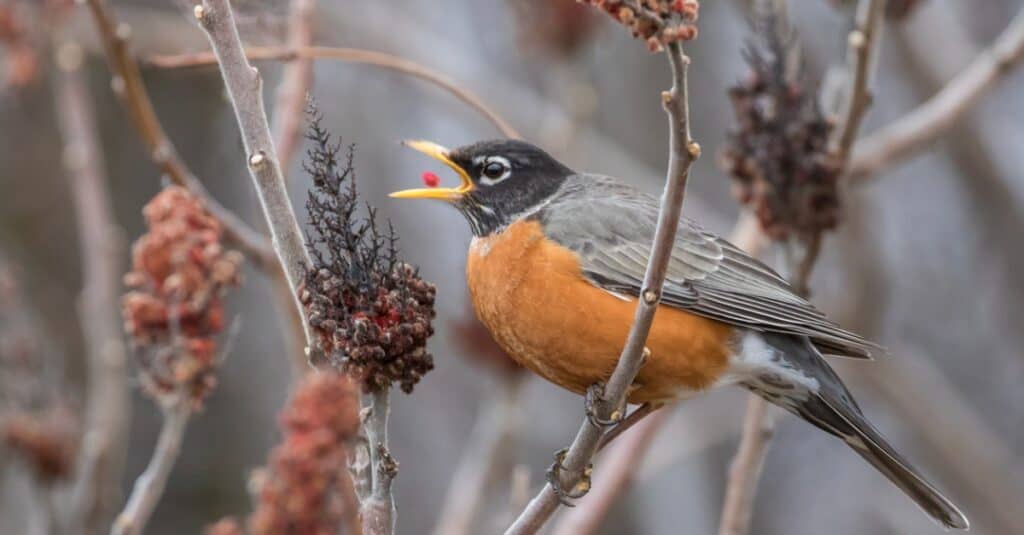
The
American Robin
prefers wooded areas and those with short grass in Ohio.
©iStock.com/mirceax
The primary habitats of American robins include forests, gardens, orchards, lawns, and open spaces. They favor fields with short grass or no vegetation for foraging, nearby wooded areas, or a few scattered trees and bushes for nesting and roosting.
These habitats are typically found in suburban and rural settings; hence American robins are often found close to humans. You can find them in flocks, hopping around lawns and parks for food.
American robins have black heads with white borders around the eyes, orange or reddish bellies, brown backs, and yellow beaks. Although the male American robin has brighter colors than the female, they both have similar appearances.
They have adaptable diets and will consume what is readily available, depending on the time of year. Fruits and berries during the winter, while they feed on earthworms and insects in the spring.
They are sociable creatures, especially in wintertime when they congregate in great numbers on their wintering grounds. They gather in sizable flocks at night and roost in the trees, typically in a remote swamp or densely-vegetative area.
#6 House Wren
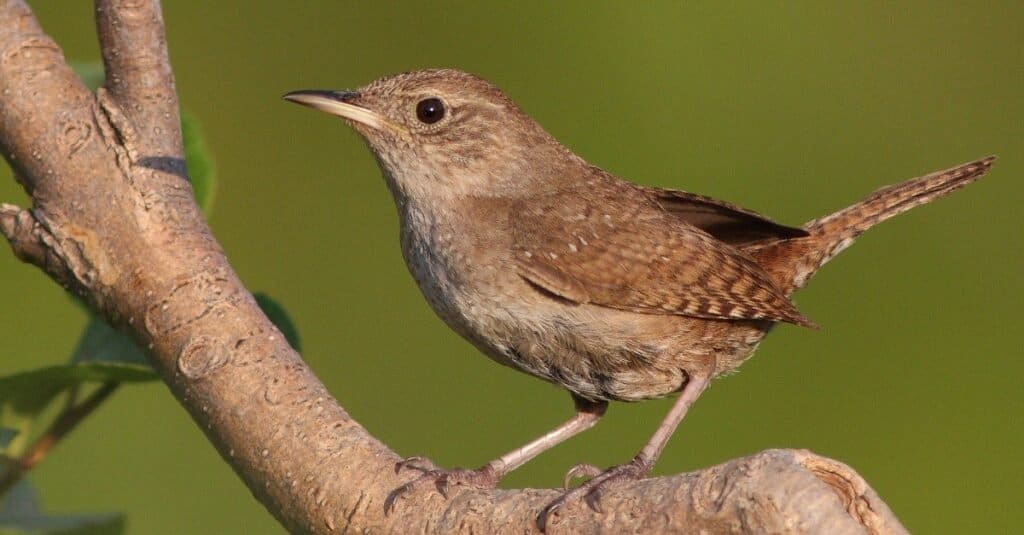
House wrens have a sweet melodious song that fills the air in Miami Heights and other areas of Ohio.
©iStock.com/mirceax
The House Wren is a common backyard bird that got its name because it likes to build its nests close to people’s residences or in birdhouses. Wrens spend the winter in riparian forests, thickets, savannas, and shrubby and brushy habitats in the Southern U.S.
House wrens lack any conspicuous marks or prominent colors. Instead, nearly all their heads, napes, and backs are brown, with fine, deeper brown stripes. Like other wrens, they have long, curved bills and perch in a peculiar position with an upright tail.
What they lack in colors, they make up for it with their burst of energy. In addition, they are known for their melodious songs and a tendency to bounce around parks and gardens.
They are primarily insectivorous; they feed on many insects, including grasshoppers, moths, beetles, caterpillars, flies, and crickets. In addition, they eat some snails, millipedes, and some spiders.
#7 Tufted Titmouse
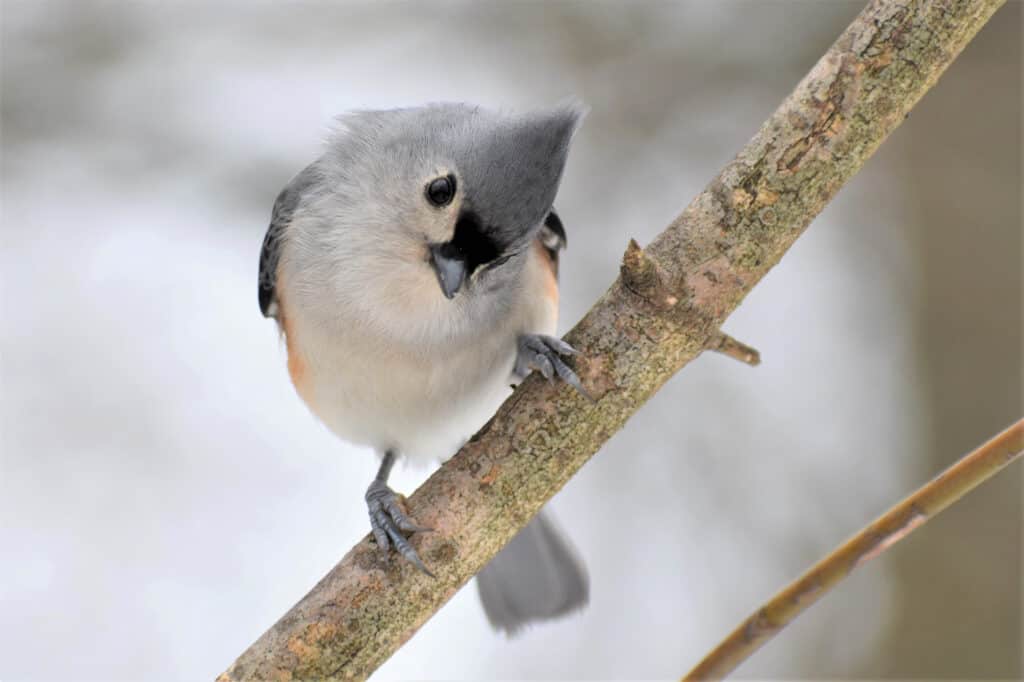
You can find Tufted titmice feeding on seeds, fruits, and insects in Ohio’s wooded areas.
©Lester Graham/Shutterstock.com
The wingspans of tufted titmice range from 23 to 28 cm and are 15 to 17 cm long. Large dark eyes, rusty-brown flanks, gray backs, and white undersides are features shared by both males and females. They also have pointy crests on their heads.
They prefer to live in deciduous forests, particularly wet woodlands in marshes and river basins. They are also typical in urban parks and residential neighborhoods with trees.
Their diverse diet includes suet, seeds, fruits, insects, and spiders. Tufted titmice are strategic in their search for prey. They may chip at an acorn or seed secured between their strong feet or hang upside down to forage on tree branches.
Like other titmice, the Red-headed Woodpecker, and other chickadees, the Tufted Titmouse stores seeds around its habitat throughout the fall and winter.
Where Is Miami Heights Located on a Map?
As a suburb of Cincinnati, Miami Heights is about 23 kilometers (14 miles) northwest of the city center. The primary route through the city is Ohio State Highway 264 (Bridgetown Road), which travels west into Cleves and east into Mack and Bridgetown. It’s bordered by Cleves to the west, Grandview to the north, North Bend to the southwest, and Mack to the south and east.
The photo featured at the top of this post is © Stephanie A Sellers/Shutterstock.com
Thank you for reading! Have some feedback for us? Contact the AZ Animals editorial team.







